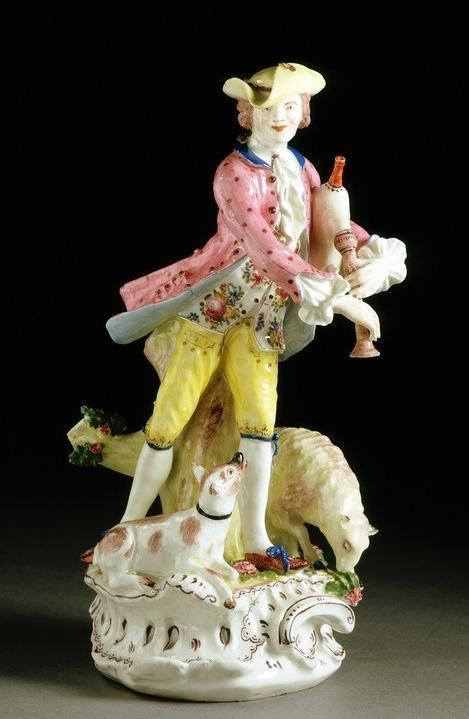 | ||
The Bow porcelain factory (active c. 1747–64 and closed in 1776) was an emulative rival of the Chelsea porcelain factory in the manufacture of early soft-paste porcelain in Great Britain. The factory was located near Bow, in what is now the London Borough of Tower Hamlets. The local council owns a significant collection, which is in the care of the borough's Heritage and Arts Service.
History
Designs imitated imported Chinese and Japanese porcelains and the wares being produced at Chelsea, at the other end of London. Meissen figures were copied, both directly and indirectly through Chelsea. Quality was notoriously uneven; the warm, creamy body of Bow porcelains is glassy and the glaze tends towards ivory.
Early patents applied for by Thomas Frye and his silent partner Edward Heylyn in December 1744 (enrolled 1745) and a totally different patent of 1 November 1748 (enrolled March 1749), both apparently intended broadly to cover the uses of kaolin, do not seem to have resulted in any actual manufacture before about 1749, though Frye's published epitaph claimed he was "the inventor and first manufacturer of porcelain in England." "Heylyn and Frye do not appear to have had a factory of their own, but probably carried on their experiments at a factory already existing at Bow, having first secured the services of a well-skilled workman whose name has not been preserved, and who may have been the real inventor of English porcelain," a writer noted in 1911.
The earliest Bow porcelains are of soft-paste incorporating bone ash, forming a phosphatic body that was a precursor of bone china. By 1750 Frye was serving as manager of the factory, under new owners, John Crowther and Weatherby. In 1753 they were advertising in Birmingham for painters and a modeller. Sources for the early history of the Bow manufactory were collected by Lady Charlotte Guest in memoranda, diaries, and notebooks, including a diary of John Bowcocke, who was employed in the works as a commercial manager and traveller. The works, designated 'New Canton,' were sited on the Essex side of the River Lea, close to Bow Bridge.
About 1758, the manufactory's high point, 300 persons were employed, 90 of whom were painters, all under one roof. "An account of the business returns for a period of five years shows that the cash receipts, which were £6,573 in 1750–1, increased steadily from year to year, and had reached £11,229 in 1755. The total amount of sales in 1754 realized £18,115." The firm had a retail shop in Cornhill and a warehouse at St Katharine's near the Tower, though a West End shop that was opened in 1757 in the Terrace in St. James's Street closed the following year. The part-owner Weatherby died in 1762 and his partner Crowther was listed as bankrupt the following year. Three sales dispersed his effects in March and May 1764. Though Crowther continued in business in a small way, in 1776 what remained of the Bow factory was sold for a small sum to William Duesbury, and all the moulds and implements were transferred to Derby: see Chelsea porcelain factory.
The chaser and enamellist George Michael Moser, a key figure in the English Rococo and a founder of the Royal Academy, modelled for Bow, the sculptor Joseph Nollekens was told years later; the sculptor John Bacon also modelled for Bow in his youth. The large white figure of the Farnese Flora, a high point in the Bow production, was taken, it has been suggested, from a terracotta by Michael Rysbrack.
A pair of Bow figures of Kitty Clive and Henry Woodward as "the Fine Lady" and 'the Fine Gentleman" in David Garrick's mythological burlesque Lethe, 1750–52 "are probably the earliest full-length portrait figures in English porcelain"; some figures bear the incised date 1750, the earliest dates on Bow porcelain. Some were enamelled by William Duesbury. Some Bow figures were imitated from Chelsea models. Bow porcelain adopted the newly invented technique of transfer printing from Battersea enamels in the 1750s.
